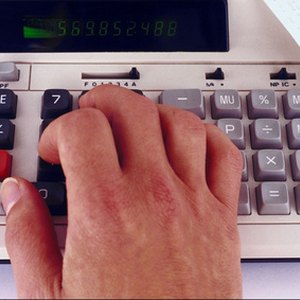
When you take out a loan, the lender typically amortizes the loan over the repayment period and gives you a monthly payment amount based on the interest rate. If you have a fixed-rate loan, this payment will stay the same. If you have an adjustable rate, the monthly payment will only change when the interest rate changes. With each payment, part goes to paying the interest that accrues on the loan and part goes toward paying down the principle. If you know your balance and how much went toward paying down the interest, you can calculate the annual interest rate.
Check your loan statement or contact your financial institution to determine your outstanding balance on your loan at the start of payment period and the amount of your most recent payment that went toward paying interest.
Divide the amount of your payment that went toward paying interest by the outstanding loan balance at the start of the payment period to find the periodic rate expressed as a decimal. For example, if your balance was $10,000 and over the payment period $50 of interest had accrued so $50 of your payment went to interest, you would divide 50 by 10,000 to get 0.005.
Multiply the periodic rate expressed as a decimal by the number of payments you make per year to find the annual rate expressed as a decimal. In this example, if you made monthly payments, you would multiply 0.005 by 12 to get 0.06.
Multiply the annual rate expressed as a decimal by 100 to convert to the annual rate expressed as a percent. Finishing this example, you would multiply 0.06 by 100 to find the annual interest rate of 6 percent.
References
- Foner Books: How to Calculate Mortgage Payments
- Math Forum: Loans and Interest
- Purple Math: Converting Between Decimals, Fractions and Percentages
- Consumer Financial Protection Bureau. "What Is an 'Interest-Only' Loan?" Accessed July 1, 2020.
- Consumer Financial Protection Bureau. "What Is Amortization and How Could It Affect My Auto Loan?" Accessed July 1, 2020.
- California State Board of Equalization. "Lesson 7: Periodic Repayment (Assessors’ Handbook 505, Column 6)." Accessed July 1, 2020.
- MIT OpenCourseWare. "Chapter 17: Mortage Basics II: Payments, Yields, and Values." Accessed July 1, 2020.
- Bank of America. "Example of Credit Card Agreement for Bank of America Visa Signature Accounts," Page 8. Accessed July 1, 2020.
- Board of Governors of the Federal Reserve. "Regulation Z Truth in Lending: Introduction," Page 12-19. Accessed July 1, 2020.
- Consumer Financial Protection Bureau. "Learn About Loan Costs." Accessed July 1, 2020.
- Consumer Financial Protection Bureau. "CFPB Report Finds Sharp Increase In Riskier Longer-Term Auto Loans." Accessed July 1, 2020.
- Consumer Financial Protection Bureau. "Can I Prepay My Loan at Any Time Without Penalty?" Accessed July 1, 2020.
Writer Bio
Based in the Kansas City area, Mike specializes in personal finance and business topics. He has been writing since 2009 and has been published by "Quicken," "TurboTax," and "The Motley Fool."

